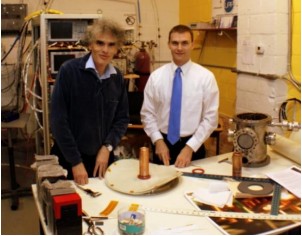Dec
2
Focus Fusion Shoots Five In A Row
December 2, 2011 | 1 Comment
For most of us the idea that a new gizmo doesn’t just run is an anomalous thought. But builders of the hardware of new ideas are usually faced with a series of mountainous climbs to get from an idea to a theory to a workable experiment to a lab model to a prototype and on to something built that others can buy. It’s not like climbing a mountain – it’s more like climbing all the mountains in a range in a row.
The dense plasma focus devices preceding FF-1 had a reputation for large shot-to-shot variability; a fusion generator (as well as most other applications) requires repeatable functioning.
For a commercial, or even for a widely acceptable test result the Focus Fusion device has to run demonstrating the level of repeatable firing needed for a fusion power generator. Focus Fusion-1 fired five shots in a row November 2nd under the same conditions with fusion yield varying by only plus or minus 2.6% from an average of 0.9×1011 neutrons.
This is progress. Back in May Lawrenceville Plasma Physics (LPP) reported the research team had succeeded in stabilizing FF-1’s output to within a range of plus or minus 15%. The latest, tighter stability of function represents a six-fold improvement over the May results and achieves approximately the range of reliability that would be required in a generator pulsing many times per second.
The report available as a downloadable pdf file discusses the improvement from more attention to the variances in the device’s energy emitting parts called electrodes. The team made modifications to the central o-ring and insulating Mylar sheets to eliminate a small tilt detected in the alignment of the electrodes. The alignment of the electrodes is critical in producing a symmetric current sheath, which in turn is needed to get the highest compression of the plasmoid where the fusion reactions occur.
There is only a 15-mil (thousandths of an inch) clearance between the insulator and the cathode, or outer electrode, so this distance must be kept constant to within one mil around the whole circumference of the insulator. While previous efforts have accurately centered the insulator at its base, any slight tilt in the large steel plate holding the anode can create a misalignment when the insulator passes close to the cathode.
The team found there was a small error in the dimensions of a rubber o-ring that surrounds the anode and provides a vacuum seal to prevent air from entering the vacuum chamber. Because the ring was too thick, it did not compress enough under the weight of the upper steel plate (which is attached to the anode) to rest securely on the Mylar plastic insulating layers and the lower steel plate (which is attached to the cathode). Instead, the o-ring carried the main weight and allowed the steel to tilt slightly. A reduction in the o-ring thickness as well as adding more lead weights to increase the compression will cure this problem.
With this matter out of the way and improvements to protect the inner assembly to electrical breakdown at future 120kV energy levels the team expects improved symmetry and fusion yield.
There is also an axial magnetic field coil that acts on the plasma along the length of the device that imposes a small field down the middle. The field isn’t strong at 2 gauss, about 6 times the field on the earth’s surface. But it spins the plasma and gets amplified when moving down the electrodes – much like a speeding bullet. The record run of 5 in a row ended when the team set the field coil to double power at 4 gauss.
LPP also has added an IT person contracted to speed things up as well. When a shot is made it was taking several minutes to dump the data off the six monitoring oscilloscopes. Now data comes out in under a minute. Next up is better data processing.
Dr. Lerner has what one sees as the opposite to the giant uber expensive ITER project. FPP confines in the tiniest high-energy environment that man’s imagination has come up with. It also seems to be stepping up to the goal – one laborious step by step.
While the LPP and the FF-1 isn’t fraught with lots of controversy on the outside, the mountains are getting climbed one by one and the theory is fitting the test results. It’s till a long ay to go. Building the first fusion device that might run constantly is a tall order over many tall engineering problems.
It’s getting done – so congratulations are in order and sent.
Comments
1 Comment so far



What does an aneutronic fusion generator look like? Only a few SciFy writers know for sure. But, these guys are building one from scratch. And, since their background is mostly theoretical – there is a lot of trial and error.
I am still amazed that they began their machine using off the shelf automotive spark plugs! And, when they have a problem with a vacuum seal – often they just post a note about it on their forum and ask for help from any reader who might know the answer.
What they are doing, is like building a automobile without a blue print. And, like Edison said, it is ‘1% inspiration and 99% perspiration.’
Thomas Edison and Philo Farnsworth would both be proud of those guys.